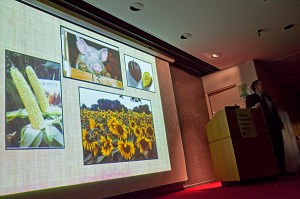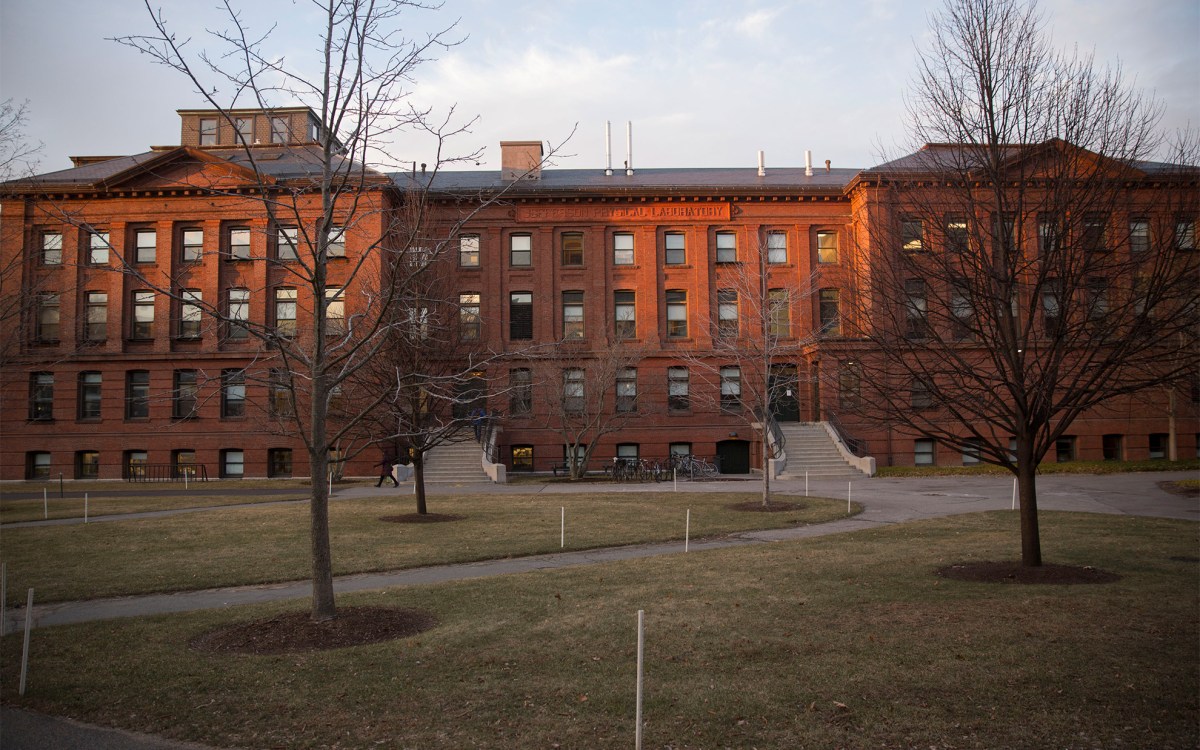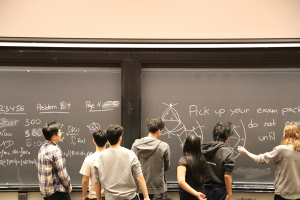Tag: Animals
-
Campus & Community
More than just meat
Vegan Carol J. Adams speaks about meat eating as more than violence against animals, saying that it’s also often an expression of violence against women.

-
Health
Hey squash, time for your close-up
Bruce Smith, of the Smithsonian National Museum of Natural History, discusses the rise of agriculture in a talk at the Harvard Museum of Natural History.

-
Campus & Community
Around the Schools: Faculty of Arts and Sciences
What’s small, four-legged, and leaves dusty paw prints on telescope mirrors? That’s what astronomers at the Harvard-Smithsonian’s Whipple Observatory in southern Arizona were trying to find out.
-
Science & Tech
Trading energy for safety, bees extend legs to stay stable in wind
New research shows some bees brace themselves against wind and turbulence by extending their sturdy hind legs while flying. But this approach comes at a steep cost, increasing aerodynamic drag and the power required for flight by roughly 30 percent, and cutting into the bees’ flight performance.
-
Health
Evolution explored from all angles
From humanity’s close relationship to chimpanzees to the missing link between land and sea creatures, the Harvard Museum of Natural History (HMNH) has capped off a year celebrating Darwin and “On the Origin of Species” with a new exhibit that puts evolution front and center.
-
Science & Tech
Vocal mimicking, sense of rhythm tied
Researchers at Harvard University have found that humans aren’t the only ones who can groove to a beat — some other species can dance, too. The capability was previously believed to be specific to humans. The research team found that only species that can mimic sound seem to be able to keep a beat, implying…
-
Science & Tech
Climate change an ‘opportunity’ as well as a threat
Conservation pioneer Russell A. Mittermeier started this year’s Roger Tory Peterson Memorial Lecture (April 5) with a quiz. In front of several hundred listeners at Harvard’s Science Center he turned on a small recorder.
-
Campus & Community
Unleashed pets barred from Yard
Effective April 1, unleashed pets will no longer be allowed in Harvard Yard. All pets, with the exception of service animals, must be on a leash at all times.
-
Campus & Community
Unleashed pets barred from Yard
Effective April 1, unleashed pets will no longer be allowed in Harvard Yard. All pets, with the exception of service animals, must be on a leash at all times. This policy is designed to ensure the safety of residents, staff, and visitors. This policy will be strictly enforced in the Yard by the Harvard University…
-
Science & Tech
Modeling the forest … and the trees
When building computer models of the ecosystems that cover the earth’s surface, it is tempting to incorporate sweeping generalizations in your calculations.
-
Science & Tech
Humanity may hold key for next Earth evolution
Human degradation of the environment has the potential to stall an ongoing process of planetary evolution, and even rewind the evolutionary clock to leave the planet habitable only by the bacteria that dominated billions of years of Earth’s history, Harvard geochemist Charles Langmuir said Thursday (Nov. 13).
-
Science & Tech
Wildlife Conservation Society chief outlines scenarios
From the complex social structure of elephant herds to the understanding that gorillas are susceptible to deadly “human” diseases to the impacts of climate change, conservationists are struggling to balance a suite of challenges unknown in past generations.
-
Health
Global ‘chump change’ could provide biodiversity protection
Harvard biologist Edward O. Wilson said the Earth’s major biological hot spots could be conserved for roughly $50 billion— an amount he termed “chump change” in a world of trillion-dollar financial bailouts.
-
Campus & Community
Cabot Science Library catches migration in exhibit case
Roadkill may seem an odd inspiration for a library exhibition, but when a colleague mentioned an article about the rising number of migratory animals killed on roads and highways, Cabot Science Reference Librarian Reed Lowrie knew he’d stumbled onto his next exhibit.
-
Health
Reading human history in the bones of animals
In a Siberian cave Patrick Wrinn found bones: bones of sheep and goats, bones of extinct bison and horses, of mammoths and wooly rhinoceroses. Wrinn, a doctoral student in archaeology at the University of Arizona and member of the Harvard Class of 1998, is trying to find out who — or what — put the…
-
Science & Tech
Arctic ice is thinning steadily
There was a polar bear sighting at Harvard last week. At Pforzheimer House on Thursday (Oct. 2), global warming expert James J. McCarthy delivered a crisp summary of how fast ice is melting in the Arctic — and why we should care. The audience of 80 took in his companion slide show, including images of…
-
Campus & Community
The pine beetle’s tale: Destructive insect has pharmaceutical potential
Researchers at Harvard Medical School and the University of Wisconsin, Madison, have discovered how beetles and bacteria form a symbiotic and mutualistic relationship — one that ultimately results in the destruction of pine forests. In addition, they’ve identified the specific molecule that drives this whole phenomenon.
-
Campus & Community
Translating the color code
From snail shells to bird feathers to the changing skin of a chameleon, nature uses colors in ways that range from the electric blue of a poison dart frog’s warning to the invisible ultraviolet patterns of flowers that call bees to pollinate. The development, use, and perception of color is the subject of a new…
-
Campus & Community
And quiet flows the Don at Pusey
The Harvard Map Collection presents its fall exhibition, “From the Amazon to the Volga: The Cartographic Representation of Rivers,” which opened Wednesday (Sept. 24). For centuries, cartographers have wrestled with the difficulties of depicting rivers, and in the process they have devised many ingenious ways of answering the challenge — from streambed profiles to bird’s-eye…
-
Health
Seeing what they hear, to better understand ourselves
It was a long drive from St. Louis to Florida, but Darlene Ketten had finally made it. Standing in the warm surf of St. George Island, she watched with delight as tiny, colorful bean clams popped out of the sand and then quickly reburied themselves as the waves foamed around her calves.
-
Arts & Culture
J.J. Audubon the beginner featured in new book
Although the name John James Audubon is synonymous with beautifully detailed, scientifically accurate drawings of birds, many of his early drawings were destroyed by Audubon himself, but an intriguing selection remains in the collections of Harvard’s Houghton Library and the Ernst Mayr Library of the Museum of Comparative Zoology (MCZ).
-
Health
Jamaican lizards’ calisthenics mark territory at dawn, dusk
What does Jack LaLanne have in common with a Jamaican lizard? Like the ageless fitness guru, the lizards greet each new day with vigorous push-ups. That’s according to a new study showing that male Anolis lizards engage in impressive displays of reptilian strength — push-ups, head bobs, and threatening extension of a colorful neck flap…
-
Health
When threatened, a few African frogs can morph toes into claws
Biologists at Harvard University have determined that some African frogs carry concealed weapons: When threatened, these species puncture their own skin with sharp bones in their toes, using the bones as claws capable of wounding predators.
-
Health
Animal interaction behind ‘Cambrian Explosion’?
Harvard Professor of Biology and of Geology Charles Marshall presented his Tuesday (April 29), suggesting that it was an increase in interactions between species, such as predation, that drove an escalating evolutionary process that led to the development of teeth and claws and the wide variety of characteristics that we see among Earth’s animals today.
-
Health
Common aquatic animals show resistance to radiation
Scientists at Harvard University have found that a common class of freshwater invertebrate animals called bdelloid rotifers are extraordinarily resistant to ionizing radiation, surviving and continuing to reproduce after doses of gamma radiation much greater than that tolerated by any other animal species studied to date.
-
Health
Of flies and fish
During her schooldays in 1950s Germany, Christiane Nüsslein-Volhard rarely did her homework. In 1995, she won the Nobel Prize for physiology and medicine. Volhard is now director of the prestigious Max Planck Institute for Developmental Biology in Tübingen, where, decades before, she had been an undistinguished biochemistry undergraduate. She was at Harvard this week (March…
-
Health
Homing in on features of ‘humaniqueness’
Shedding new light on the cognitive rift between humans and animals, a Harvard University scientist has synthesized four key differences in human and animal cognition into a hypothesis on what exactly differentiates human and animal thought.
-
Science & Tech
Impact of global warming on health debated
Disagreement over the public health impact of global warming emerged in a symposium Monday morning (Feb. 18) at the annual meeting of the American Association for the Advancement of Science. The colloquium, titled “Sustaining Human Health in a Changing Global Environment,” addressed what hazards can be expected as a result of rapid and continuing climate…
-
Health
Chimpanzees have ‘top guns’ on hunts
While hunting among chimpanzees is a group effort, key males known as “impact hunters” are highly influential within the group. They are more likely to initiate a hunt, and hunts rarely occur in their absence, according to a new study. The findings, which appear in the current issue of Animal Behaviour, shed light on how…
-
Health
Study: Single muscle far more complex than previously believed
New research from Harvard’s Concord Field Station has shown that the common perception of a muscle as a single functional unit is incorrect and that different sections within an individual muscle actually do different work.


